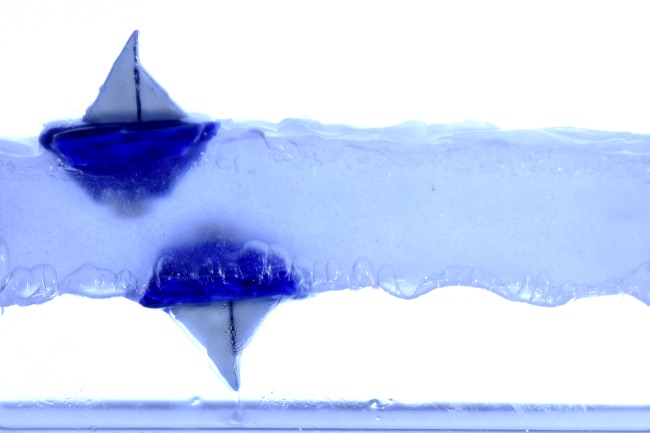It might look like a magic trick, or an optical illusion of sorts. But no, your eyes don’t deceive you — that little boat you see above does, indeed, float upside down.
A good magician doesn’t reveal their tricks. Scientists, however, do the exact opposite. A team of researchers in France detail this phenomenon in a new study published today in Nature, showing how vigorously shaking a container full of silicone oil or glycerol can create a levitating pocket of liquid that allows these small boats to float upside down.
The French researchers were curious about the behavior of liquid boundaries and so sought to understand the properties of objects in levitating liquids. To make the liquid levitate, the team used an approach known as vertical shaking. By inserting bubbles of air into glycerol or silicon oil and then shaking the container vertically it is possible to make a dense liquid float on the less dense air. It is also possible to create multiple layers of levitating liquid.
his method has been well-established and researchers have marveled at the peculiar phenomena they have witnessed. The most mind-boggling discovery so far was that bubbles of air in the suspended layer can sink instead of rising. The team took it one step further and showed that there is certainly a selective falling when it comes to heavy bodies. They don’t just sink down to the bottom of the container. A force of inverse floating similar to the Archimedes principle acts on the bodies, even on the lower side.
In the experiment, the team used half a liter of liquid with a maximum width of 20 centimeters (7.9 inches). In this liquid objects floated on both surfaces if they were up to 7 grams and 2.5 centimeters (about 1 inch). The inverse-floating worked only when the system was made to oscillate tens of times per second.
The team believes that the setup of the experiment is key to explaining the antigravity pull of the liquid on the little boat and the various masses tested in the study. In a lift, depending on if it’s going up or down, you would experience an effective gravity that it is higher or lower than the gravitational pull of the Earth, depending on the direction of travel. A free-falling lift might make you feel like you are floating.
The same forces are at play here. The rapid oscillation keeps the liquid floating. This produces a buoyancy pull instead of a push, an anti-gravity effect, that keeps objects floating upside-down instead of falling.
Other than a very cool video, the possible applications of this study might go beyond physics. Systems with high-frequencies excitations are found in biology and chemistry and counter-intuitive phenomena might be found there as well.















